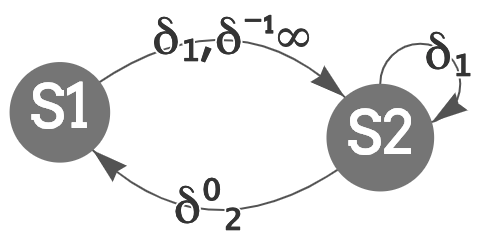Dependence
Flow (True) RAW hazard
S1 a = ..
S2 .. = a
Denoted S2 δ S1
Anti WAR hazard
S1 .. = a
S2 a = ..
Denoted S2 δ-1 S1
Output WAW hazard
S1 a = ..
S2 a = ..
Denoted S2 δ0 S1
Iteration Space
Iteration vector I of iteration is the vector of integers containing numbers for loops in order of nesting level.
The iteration vectors are ordered by execution order.

Depending on the iteration in which two statements are executed, we can two types of loop-based dependencies: Loop-independent dependency
If statement S2 depends on S1 and S1,S2 execute in the same iteration. Distance (0,0,..) and Direction (=,=,..). Loop-carried dependency
If statement S2 depends on S1 and S1,S2 execute in different iterations.
Distance and Direction
Dependence distanceIf dependence is between iteration Iwrite and Iread, then distance is Iread - Iwrite.
Example: Write A(10,11) at iteration (5,5). Read A(10,11) at iteration (5,6). Distance is (0,1).
If dependence distances all same, then say loop has that dependence distance. But, loop may have many different dependence distances.
Direction vector summarises directions. If first non = element is < then indicates flow dependence.
- < - All +ve
- > - All -ve
- = - All 0
- * - Mixed
For example, given distances:
- (0, 1, -1, -1)
- (0, 2, -2, 0)
- (0, 3, -3, 1)
Direction is:
- (=, <, >, *)
You can also check the Compiler Optimization course slides on the Iteration Space topic here.
Dependency Graph
Rather than looking at the problem in terms of iterations, we can consider statements individually: on what other statements they depend and specify the type and the level of loop carried dependence. We can visualize the dependence in this delta graph regardless of the number of loop levels as we are not limited at 2. Here the nodes are the statements and the edges are the delta-notation of the dependencies.
Level of loop carried dependence
Level of loop carried dependence is the index of the left-most non = in direction vector. Written as subscript, e.g.
- δ1 for (<, =, =)
- δ-13 for (=, =, >)
- Infinity for in same loop, e.g. δ∞ for (=, =, =)
Consider the following example:
Loop-carried:
- A(I,J-1) and A(I,J) in S1 could have created a WAR dependence of distance (0,-1) and direction (=,>) => δ-12, but A(I,J) is overwritten in S2 - we don't include this in our dependence graph.
- A(I,J-1) from S1 and A(I,J) from S2 create a WAW dependence of distance (0,1) and direction (=,<) => δ02
- A(I,J-1) from S1 and A(I-1,J-1) from S2 create a RAW dependence of distance (1,0) and direction (<,0) => δ1
- A(I,J) and A(I-1,J-1) from S2 create a RAW dependence of distance (1,1) and direction (<,<) => δ1
Loop-independent:
- A(I,J) from both statements create a WAW of distance (0,0) and direction (=,=) => δ0∞
The resulting dependence graph is this:

You can also check the Compiler Optimization course slides on the Dependence Graph topic here.
- 2 writes (either which can potentially write to both),
- 1 write (which can write after read) and 1 read (which can read after write).